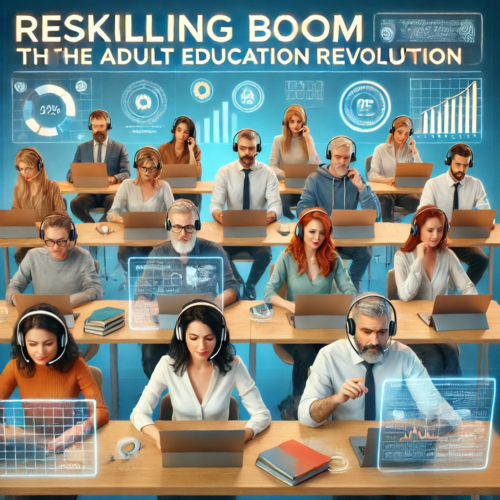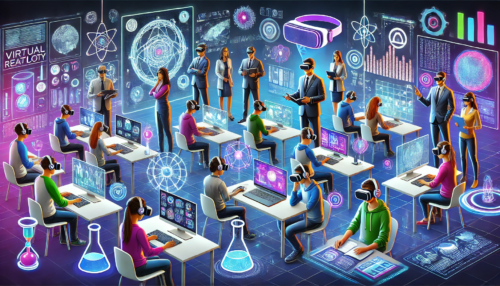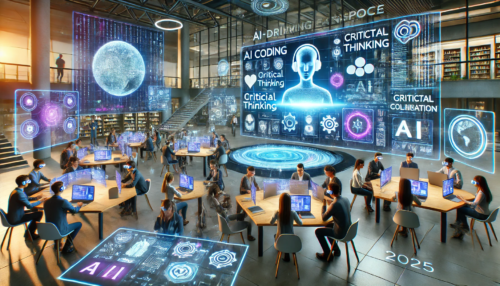AI Mentors: Personalized Learning Paths
Student-centric tutoring powered by predictive analytics.
Ever had that sinking feeling of being lost in a huge classroom, where the teacher’s lecture whizzes by, and you’re still stuck on yesterday’s topic? Or maybe you’ve been the one breezing through all the material, impatiently waiting for the rest of the class to catch up. In 2025, that disconnect is on the verge of extinction—courtesy of AI Mentors. These digital tutoring companions know exactly what you need to learn and when, tailoring your journey like a personal map. And yes, they’re powered by some seriously smart predictive analytics. Let’s unearth how these AI Mentors are redefining the academic world, sprinkling in a bit of messy politics, generational insights, scientific research, and a dash of celebrity influence.
Shifting the Educational Paradigm: AI Mentors Leading the Way
The classic “one-size-fits-all” classroom model is officially on life support. School boards and government agencies across continents are scrambling to approve budgets for AI-based tutoring systems. According to a report from various ministries of education (some in Europe, others in parts of Asia), there’s a collective push to adapt curricula for more individualized learning. The idea is simple: feed student performance data into AI algorithms, generate predictive analytics, and voilà—each learner gets an evolving study plan catered to their strengths and weaknesses.
Just last year, a government official in Japan boasted that AI Mentors could reduce dropout rates. A distant cousin in the U.S. House of Representatives echoed that sentiment, proposing a bill that funds “Adaptive Learning Labs” in underserved communities. Of course, critics say not all schools can afford the technology just yet. But momentum is building. And in typical political fashion, a handful of lawmakers are already jostling for credit, proclaiming, “We championed the AI tutoring revolution first!” Let’s see how that plays out in the next election cycle.
Political News and the Funding Puzzle
Where money flows, politics often follows. Legislative bodies worldwide are debating how to allocate funds to integrate AI Mentors into public schools. Some champion universal access, believing that predictive analytics can be a game-changer for at-risk students. Others argue that private EdTech companies may monopolize the sector, charging outrageous subscription fees or controlling data. This tension has spawned a spree of “AI Mentor pilot projects,” often launched to gather evidence on outcomes before large-scale deployment.
In one heated debate, a progressive politician insisted that AI Mentors should be as standard as textbooks, with the state footing the bill. A more conservative voice retorted that the private sector’s competition ensures the best innovation. Meanwhile, nonprofits that focus on bridging educational gaps anxiously watch, hoping these AI Mentors don’t just serve privileged schools but also rural areas, adult-learner programs, and vocational training centers.
Why Personalized Learning Paths?
To understand the hype around AI Mentors, let’s address the core question: why do we need personalized learning? Data from educational think tanks like the OECD show that a large portion of students fail to reach basic proficiency in math or reading when taught in generalized classrooms. On the flip side, advanced learners lose interest and motivation due to lack of challenge. AI Mentors tackle both ends of this spectrum—customizing lessons to fill gaps and accelerating content for those who are ready.
Add predictive analytics to the mix, and you get a system that can forecast the exact moment a student will struggle with fractions or need a reminder about grammar rules. Then, with an almost spooky sense of timing, the AI Mentor swoops in with targeted exercises, short videos, or dynamic quizzes. Think of it as a personal trainer who spots you right before you drop that barbell—no more, no less.
Research Labs & Scientists Weigh In
If you’re wondering if all this is just hype, well, the research labs are buzzing. Scientists in advanced education labs from MIT to small centers in Finland are analyzing success metrics, drop-off rates, and emotional engagement. Many rely on the broader field of “learning analytics,” an umbrella term for methods that measure how students interact with course material, how quickly they progress, and when they might disengage.
“We’re seeing a 15 to 20 percent improvement in comprehension levels when AI Mentors proactively intervene,” notes Dr. Simone Bennet, a cognitive scientist at a leading research institute. She also points out that emotional factors—like students feeling left behind or bored—play a critical role in long-term retention. AI Mentors, equipped with empathy modules and real-time feedback loops, can sense frustration or boredom in a student’s digital body language (like quick answer skips or repeated quiz failures) and adapt the pace accordingly.
Yet, not everyone’s sold. Some neuroscientists argue that deeper learning requires offline experiences—hands-on experiments, group projects, or practical demonstrations that AI can’t fully replicate. Possibly true. The consensus, though, is that AI Mentors excel at bridging knowledge gaps in ways that standard textbooks or large classrooms might not.
Celebrity Buzz: Rockstars and Film Icons on Board
You’ve likely seen the headlines. A famously flamboyant pop star launched a charity initiative to deploy AI Mentors in disadvantaged neighborhoods. Meanwhile, a top-grossing actor—known for philanthropic gestures—boasted that AI-driven tutoring helped his nephew pass advanced calculus. Whether these endorsements come off as starry-eyed or strategic PR, they tend to stir conversation.
In a recent interview, a global R&B icon declared that “Predictive analytics took the guesswork out of learning for my cousins,” praising how each subject was taught precisely at their level. Could it be hype? Possibly. But no doubt, celebrity endorsements help break down skepticism among parents or older folks who wonder if AI mentors are a glitchy distraction. Some older critics remain suspicious, conjuring images of robotic teachers with no soul. We’ll get to that in a minute.
Older Generations: Blending Curiosity and Concern
Grandparents across the globe often voice the classic line, “Back in my day, we learned everything from a chalkboard, and we turned out fine.” Indeed, old-school education has a charm—handwritten notes, real-time teacher praise, and the camaraderie of a physical classroom. So, how does the older generation feel about AI Mentors?
Opinions vary. Some see them as remarkable tools, especially for grandkids who might struggle with reading or advanced science concepts. “If that AI can help my granddaughter decode new vocabulary words, more power to it,” one retiree told a local news channel. Others fear over-reliance on machines, worried that personal, human connections might erode. The tension is understandable. However, supporters argue that AI Mentors don’t replace teachers; they augment them, freeing teachers to focus on emotional guidance and deeper discussions while the AI handles repetitive drills.
On the social front, older communities wonder about cost and accessibility. Government-subsidized programs may quell those concerns. Meanwhile, philanthropic efforts like the pop star’s initiative aim to ensure that older learners—who might need adult literacy classes or specialized courses—get a shot at AI mentorship, too. After all, who says advanced learning is just for the young?
Young Learners: Eager, Distracted, or Both?
Now, spin the camera onto the youth. They’re glued to TikTok, Instagram Reels, or whichever new platform is trending. Will they embrace AI Mentors or ignore them in favor of cat videos? Intriguingly, many digital natives find AI Mentors quite appealing. A teenager might say, “I get bored in math class, but my AI Mentor challenges me with mini-quizzes in between my gaming sessions.” Others appreciate the 24/7 availability—no more waiting until the next school day to get a question answered.
But let’s not forget the potential pitfalls. Younger folks might treat AI Mentors like yet another app they can snooze whenever they want. Maintaining motivation can be tricky if the mentor is just a blinking avatar on a screen. Some schools now incorporate “AI Mentor check-ins” as a structured part of the day, ensuring students use these systems properly. The results so far? It depends on the student’s learning style. Realistically, even the best AI can’t force someone to care.
Government Regulations and Ethical Considerations
One cannot dive into predictive analytics and personalized data without bumping into privacy concerns. Governments worldwide are grappling with how to regulate the use of student information. Predictive models rely heavily on personal details—grades, attendance, behavior patterns. Add “face recognition” or “mood detection” algorithms, and you’ve got a potential ethical minefield.
- Data Protection Laws: Regions like the European Union enforce strict rules (similar to GDPR) that limit how long data can be stored and how it can be shared.
- Age Restrictions: Some places require parental consent for AI Mentor usage under a certain age.
- Equitable Access: Policymakers debate whether all schools must have the same level of AI Mentors, ensuring no child is left behind due to budget constraints.
Political tensions arise if big corporations handle the data. “Our children’s futures shouldn’t be for sale,” activists cry, insisting on open-source AI solutions or public ownership of these platforms. The final shape of these regulations is still being hashed out in legislative committees, making for some heated headlines.
The Tech Behind Personalized Learning Paths
Let’s peel back the curtain a bit. So, how do these AI Mentors tailor lessons so effectively?
- Machine Learning Models: These models detect patterns in a student’s learning history—where they slow down, which topics they skip. They might use a random forest or neural network to predict future struggles.
- Adaptive Feedback: The AI Mentor triggers short assessments at strategic intervals to check comprehension. If the student aces them, it ramps up difficulty. If not, it revisits foundational concepts.
- Natural Language Processing: For language-heavy subjects, the system interprets typed or spoken responses, offering corrections or expansions. In advanced systems, it can even gauge emotional tone.
- Predictive Analytics: This is where the crystal-ball effect shines. By analyzing large data sets from thousands of learners, the system anticipates friction points. Some advanced AI Mentors even forecast how likely a student is to drop a course, then intervene with motivational nudges.
Of course, technical glitches happen. Some learners might trick the system by randomly clicking through tasks. Others might get false predictions because they once studied well past midnight, skewing the data. Nonetheless, each iteration refines the models. Over time, the AI becomes more accurate, more empathetic (in a digital sense), and more aligned with real classroom contexts.
Celebrity Testimonies—An Extra Boost?
We’ve all seen how major endorsements can catapult emerging technology into the mainstream. When a famous tennis player remarks on social media, “My child’s AI Mentor makes math fun,” it can do wonders for public awareness. Yet, do these celebrities truly grasp the intricacies of predictive analytics, or are they just parroting marketing lines? Hard to tell. But the net result is that everyday parents become more open to trying an AI Mentor for their kids.
Some influencers also champion adult training programs. A well-known YouTuber, known for comedic sketches, launched a collaboration with an AI learning platform. She invited fans to try out the AI Mentor for language lessons, offering discount codes. Fans jumped on board, praising the bite-sized lessons that adapt to their mistakes. Naturally, the platform soared in popularity. It’s a neat example of how star power can merge with educational technology to reach large audiences quickly.
Social Impact and Community Engagement
Neighborhood libraries are reinventing themselves, offering free or low-cost AI Mentor access to families lacking Wi-Fi at home. Some municipalities even designate “AI Mentor stations” in community centers, bridging the digital divide. On the flip side, critics argue it’s just a band-aid if the community can’t address deeper issues like poverty or illiteracy. AI Mentors, after all, thrive on consistent usage and stable connectivity.
But there are success stories. In a small town battered by economic downturn, local officials rallied funds to install high-speed internet in a refurbished building. Students can sign in to AI Mentors after school, guided by volunteer retirees who serve as emotional support. This intergenerational synergy—tech-savvy AI plus the wisdom of older mentors—has produced surprisingly good results. Kids get the best of both worlds: individualized instruction from AI and real-life encouragement from seniors.
Are Teachers Becoming Obsolete?
One of the biggest elephants in the room: does a teacher’s role diminish when AI Mentors handle much of the instruction? Most educators will tell you no. If anything, teachers have a renewed sense of purpose, freed from repetitive tasks like grading endless quizzes. They can focus on deeper interactions—facilitating debates, inspiring creativity, and providing emotional well-being checks. AI Mentors handle the grunt work of identifying knowledge gaps and offering immediate practice.
But tensions do exist. Some teachers worry about being reduced to “classroom managers” if AI handles all the academic scaffolding. That’s where training programs come in. Governments and private institutions now offer workshops on how to integrate AI Mentors effectively—equipping teachers to interpret analytics dashboards and seamlessly align the AI’s guidance with overall lesson plans.
A Peak Into Tomorrow—Evolving AI Mentors
We’re witnessing just the start. Future AI Mentors may incorporate advanced VR, letting you wander through simulated historical events or tinker with 3D virtual engineering prototypes. They might harness wearable sensors that track biometrics—heart rate, skin temperature—to gauge stress levels. This data could enhance predictive analytics, intervening right when frustration spikes. Exciting and a little eerie, right?
Some political watchers even speculate about official national platforms. Picture a country unveiling a universal AI Mentor system, free to all citizens from preschool to adult vocational programs. Dreamy or Orwellian? Depends on who you ask. It’s a bold possibility that could transform entire populations’ educational standards, bridging gaps that once felt insurmountable.
FAQs About AI Mentors
Q1: Do AI Mentors replace traditional teachers?
Not really. They function as intelligent assistants, handling repetitive instruction and pinpointing problem areas. Teachers provide real-world insights and emotional support.
Q2: Is my child’s data safe with AI Mentors?
Reputable providers abide by strong data protection protocols. However, it’s wise to review privacy policies, especially regarding data sharing and storage.
Q3: Are AI Mentors only for academic subjects?
They’re commonly used for math, science, and language, but also expanding into soft skills like communication or even specialized fields like coding.
Q4: What about cost?
Pricing varies. Some schools integrate AI Mentors through district funding, while others rely on private subscriptions. Nonprofits and charities often step in to fund low-income communities.
Q5: Does AI personalization create echo chambers?
There’s a risk that over-personalization might limit exposure to diverse viewpoints. It’s crucial to maintain a balance between individualized content and broader educational experiences.
Additional Resources & Links
- OECD Education Portal – For data and reports on international education trends.
- MIT Media Lab – Research on cutting-edge educational tech, including AI-driven learning.
- EdTech Magazine – Insights and case studies on AI integration in classrooms.
Wrapping It Up—Embracing the AI Mentor Era
As you read these words, new AI Mentors are springing up in pilot schools, bustling urban centers, and underfunded rural districts. Governments are grappling with budgets and regulations, celebrities are championing philanthropic rollouts, and research labs are refining the algorithms behind predictive analytics. The older generation weighs tradition against innovation, while younger learners experiment with a new kind of tutor that feels as natural as any app on their phone.
The bottom line: AI Mentors represent a giant leap forward in personalized learning paths. But they’re not a silver bullet. Real teachers, supportive communities, and well-structured policies remain vital. For some, the idea of entrusting so much of a child’s education to a machine might spark anxiety. For others, it’s a long-awaited liberation from cookie-cutter lessons. Whichever camp you’re in, there’s no denying we’re at the cusp of a fresh educational chapter—one that merges digital intelligence with human creativity for a better, richer learning experience.
Looking to delve deeper?
- Subscribe to our newsletter for the latest on adaptive learning tech, policy changes, and real-life success stories.
Because in 2025, the question is no longer if AI Mentors will shape student-centric tutoring—but how fast, how far, and how fairly.




